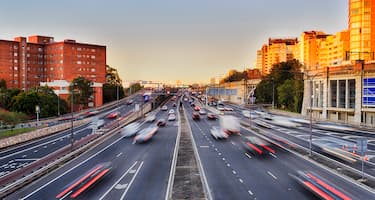In our latest survey, we surveyed 1001 Australians (aged 18+) to learn more about their experiences and beliefs towards car accidents.
We also compared these results to the latest road fatality data (from BITRE) and previous surveys from 2021 and 2023 to better understand trends and how Australians have been impacted by car accidents.
Quick Stats
Nearly 40% of Australian respondents drive on congested roads at least once a week.
Almost two-thirds of Australian respondents believed speeding was the leading cause of car accidents.
More than 56% of Australian respondents were involved in a nose-to-tail collision.
Common Causes of Car Accidents
Speeding
Speeding is either travelling faster than the legal limit or faster than road conditions allow.
Read our Speeding Survey and Statistics to learn more.
Road Rage
Road rage includes swearing, shouting, rudely gesturing, threatening or harming another driver and damaging someone else's vehicle.
Read our Road Rage Survey and Statistics to learn more.
Distracted Driving
Drivers can be easily distracted by phones, eating, drinking, smoking, vaping, applying makeup and plenty of other common day-to-day things.
Read our Distracted Driving Survey and Statistics to learn more.
Fatigued Driving
Fatigued driving can be due to a lack of quality sleep, too much driving, a lack of stimulation, or a busy social or work schedule.
Read our Fatigued Driving Survey and Statistics to learn more.
Drink Driving
One to two standard drinks can be all it takes to push people over the legal blood alcohol concentration (BAC) limit.
Read our Drink Driving Survey and Statistics to learn more.
Australian Car Accident Statistics
Road Fatalities by State
NSW |
Vic |
Qld |
SA |
WA |
Tas |
NT |
ACT |
Australia |
|
|---|---|---|---|---|---|---|---|---|---|
June 2024 |
358 |
290 |
296 |
101 |
176 |
27 |
54 |
8 |
1310 |
% change from June 23 - June 24 |
23.0% |
9.0% |
8.4% |
8.6% |
0.6% |
-30.8% |
107.7% |
-20.0% |
11.7% |
Road fatalities saw an increase, rising by 11.7% in the last year.
In the 12 months to June 2024, there were significant increases in the Northern Territory (107.7%) and New South Wales (23.0%). [1]
Road Fatalities by Speed Limit
In the last 12 months, there were 1200 road fatalities, with the majority happening in the 100km/h speed zone.
The speed limit linked to the second highest number of fatalities was 60-70 km/h.
The faster you drive the longer it takes to stop. For instance, if you were driving at 60km/h, it would take you an additional 56 metres to stop your car. [2]
Car Accident Survey Results
How frequently do you drive on congested roads?^
^Due to how the figures are rounded within the survey data, numbers may not add up to exactly 100%
Nearly 40% of Australian respondents drive on congested roads at least once a week. While nearly 20% of respondents drive on congested roads at least three times per week.
Respondents from New South Wales were most likely to drive on congested roads at least once a week. Nearly 30% of South Australian respondents drive on congested roads at least three times per week.
The percentage of Australian respondents who drive on congested roads every day and at least two to five times a week increased from the previous year.
Which roads do you feel safest driving on?^
Ranking |
Road Type |
|---|---|
1 |
Motorways/Freeways |
2 |
Main roads (multiple traffic light intersections) |
3 |
Country/rural roads |
4 |
Suburban streets |
Ranking |
2021 |
2023 |
2024 |
|---|---|---|---|
1 |
Motorways/Freeways |
Motorways/Freeways |
Motorways/Freeways |
2 |
Suburban streets |
Main roads (multiple traffic light intersections) |
Main roads (multiple traffic light intersections) |
3 |
Main roads (multiple traffic light intersections) |
Country/rural roads |
Country/rural roads |
4 |
Country/rural roads |
Suburban streets |
Suburban streets |
^Due to how the figures are rounded within the survey data, numbers may not add up to exactly 100%
For the third year in a row, Australian respondents feel safest driving on motorways and freeways and for the second year in a row, they feel the least safe driving on suburban streets.
What do you believe to be the leading cause of car accidents?^
Ranking |
Causes of Car Accidents |
|---|---|
1 |
Speeding |
2 |
Tailgating/aggressive driving |
3 |
Distracted driving (texting) |
4 |
Failure to give way |
5 |
Driving through a red light |
6 |
Driving tired |
7 |
Driving drunk |
8 |
Poorly designed roads/intersections |
Ranking |
2021 |
2023 |
2024 |
|---|---|---|---|
1 |
Speeding |
Speeding |
Speeding |
2 |
Distracted driving |
Tailgating/aggressive driving |
Tailgating/aggressive driving |
3 |
Tailgating/aggressive driving |
Poorly designed roads/intersections |
Distracted driving |
4 |
Driving drunk |
Failure to give way |
Failing to give way |
5 |
Driving tired |
Driving through a red light |
Driving through a red light |
6 |
Failing to give way |
Distracted driving |
Driving tired |
7 |
Driving through red lights |
Driving tired |
Driving drunk |
8 |
Poorly designed roads/intersections |
Driving drunk |
Poorly designed roads/intersections |
^Due to how the figures are rounded within the survey data, numbers may not add up to exactly 100%
Nearly two-thirds of Australian respondents (59%) believed speeding was the leading cause of car accidents. And 30% of Australians believed that tailgating and aggressive driving was the second leading cause of car accidents after speeding.
How many car accidents have you been in?^
^Due to how the figures are rounded within the survey data, numbers may not add up to exactly 100%
Nearly 31% of Australian respondents have been in one car accident.
Nearly a quarter of respondents from Queensland, Western Australia and South Australia have been in two car accidents.
For the third year in a row, the number of respondents who have been in at least one car accident has risen.
Which of the following types of car collisions have you been involved in?^*
^Due to how the figures are rounded within the survey data, numbers may not add up to exactly 100%
*Respondents who answered “None” to the previous question were excluded from this question.
More than 56% of Australian respondents were involved in a nose-to-tail collision. This was followed by collisions involving a sideswipe and collisions with stationary vehicles or objects.
More than 65% of respondents aged 48-57 were involved in a nose-to-tail collision. And nearly 37% of 18-27-year-old respondents were involved in a collision with a stationary vehicle.
Respondents from Western Australia were most likely to be involved in a collision with a sideswipe.
Key Takeaways
More Australians are driving on congested roads
In 2024, the percentage of Australian respondents on congested roads at least two to five times a week and every day increased from the previous year.
According to the most recent census in 2021, “91% of households reported having at least one vehicle and more than half reported having two or more vehicles”.
Cars also continue to be the most popular mode of transport to get to work across Australia. [3]
Addressing growing road congestion may positively impact environmental and health conditions.
Speeding continues to be the leading cause of car accidents
For the third year in a row, speeding was ranked the leading cause of car accidents by nearly two-thirds of Australian respondents.
According to the Victorian Government’s Transport Accident Commission (TAC), the risk of a fatality doubles with each 5 km/h increase above 60 km/h. Reducing your speed by 5 km/h can lead to at least a 15% decrease in car accidents. [4]






